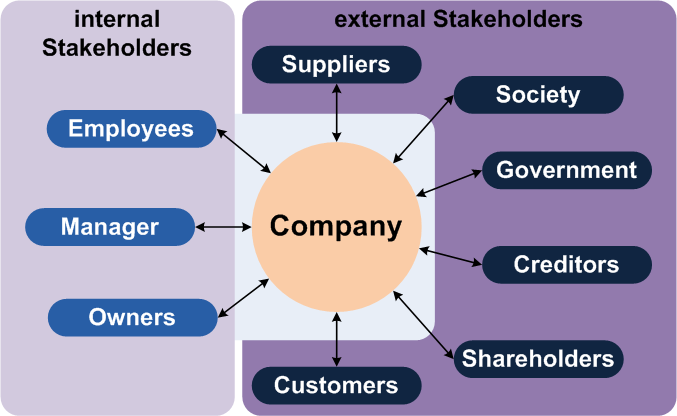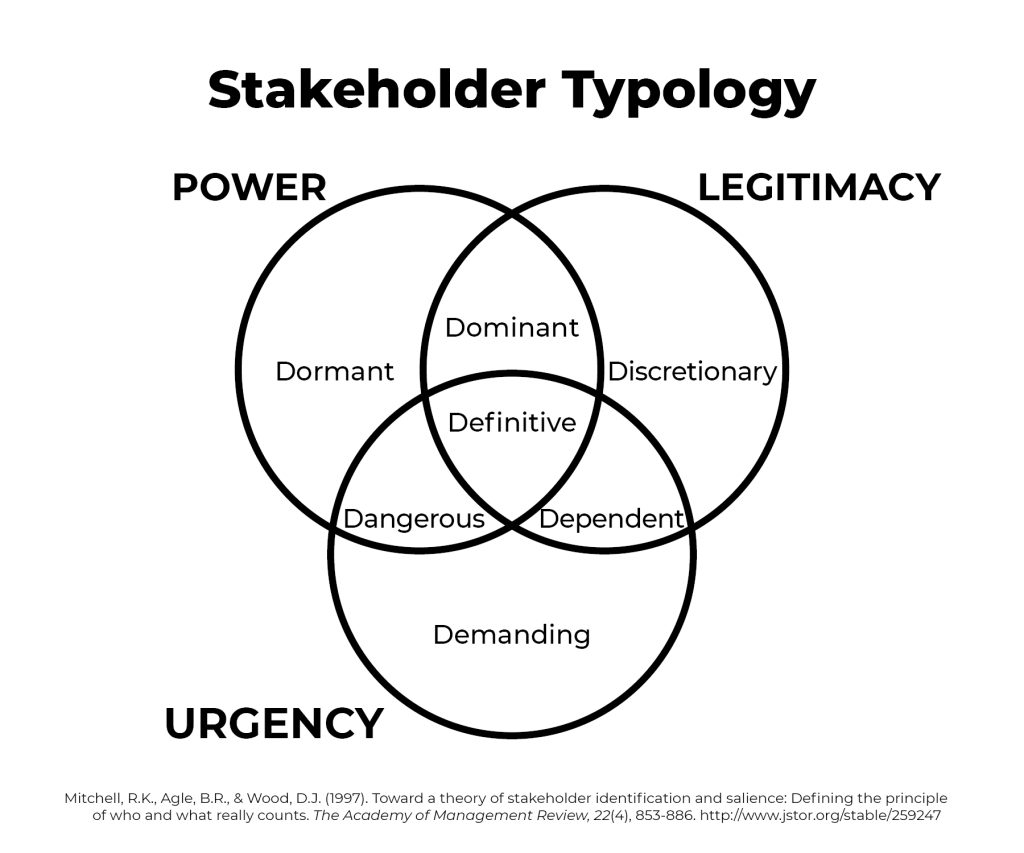Chapter 5: Stakeholder Analysis
Stakeholder analysis is an automatic and necessary extension of audience analysis. The two go hand-in-hand and some would doubtlessly argue that it should all be grouped together.
Public relations practitioners must accurately identifying the audiences (sometimes called “publics”) with whom they need productive relationships. A popular axiom for public relations is that there is no such thing as a “general public.” In other words, an organization has a variety of key groups who bring different expectations for their relationship with the organization. These differences help an organization segment its audiences into groups with similar values and expectations and to focus communication strategies.
5.1. Stakeholder Management and Prioritizing Audiences
Categorizing and ranking stakeholders is essential to the work of a public relations practitioner, notably in terms of how much attention, energy, and resources they commit to engaging with a particular stakeholder.
Difficult questions must be posed:
- To whom must the organization acquiesce?
- Who needs the organization more than the organization needs them?
- What relationships must be protected above all else?
- What relationships can be sacrificed?
Sacrificing the needs of one stakeholder for the needs of the other is a dilemma with which many organizations struggle. When these conflicts arise, organizations must have a clear understanding of these stakeholders, their relationships, and their short-term, mid-term, and long-term needs for each.
5.2. Common Stakeholders
In a corporation, there are a predictable set of stakeholders that almost any company would need to interact with: employees, customers, suppliers, regulators, and others. Some stakeholders, such as employees, are internal to the organization, while others are external.

Take note that, while owners of companies are internal, shareholders are treated as external. While they may own a small fraction of the company, the only time they have any voice is at a shareholder’s meeting and, even then, no one shareholder has much sway. If they did own a significant portion of the company, they would be classified as owners.
Other organizations have different sets of stakeholders. For example, a non-profit organization has members and donors rather than shareholders and customers. Governments are responsible to voters or citizens and revenue is generated from taxpayers, not customers (except in the case of government-owned businesses, known as “Crown corporations” in Canada).
5.3. Defining Stakeholders and Publics
In 1997, Mitchell, Agle, and Wood crafted an extremely useful method of defining stakeholders organized by three defining aspects of an organization’s relationship(s) with its stakeholder(s): urgency, legitimacy, and power.
If a stakeholder is legitimate, they have some reason for interacting with the organization. That could be a contract, as with a customer or supplier, a regulatory duty, as with government, or an ownership interest, as with a shareholder.
If a stakeholder has a sense of urgency, the need to deal with them is more immediate. For example, if employees are threatening to go on strike, suspending operations for a company, the company must address this stakeholder with a greater sense of urgency. Once an agreement has been reached and signed by both parties, discontented employees wishing for better pay must wait until the contract expires before they can renegotiate, meaning that there would be less urgency to deal with that stakeholder on that particular issue.
In any relationship, there is a balance of power, which is often dictated by the flow of money or the scarcity of resources, but not always. One interesting example is the relationship between a company and its supplier(s). If there is only one supplier for a vitally important resource that the company must have to produce its product(s), the supplier has an enormous amount of power. On the other hand, if there are many competitors offering the same resource and not enough companies wanting or needing that resource as part of their supply chain, the suppliers have very little power, as the company could always switch suppliers. In the model below, the question is whether the stakeholder has power over the organization.

Based on the intersection of these traits, stakeholders fall into one of seven categories:
- Dormant
- Discretionary
- Demanding
- Dangerous
- Dominant
- Dependent
- Definitive
(Mitchell, Agle, & Wood, 1997)
Dormant stakeholders have power over the organization, but no reason to exercise it and no urgency to do so. One example would be the power of a famous environmental activist who could turn their attention to the activities of the organization, but hasn’t and has no reason to do so, but could if the organization’s activities are environmentally sensitive and the company causes an environmental problem.
Discretionary stakeholders are legitimate, but do not have the power in the relationship and currently have no urgency to act. A common example would be those charities and goodwill causes that a company tends to support financially. Yes, there’s a relationship, but the company is under no obligation to continue it (so the charity has no power) and there’s unlikely to be any rush to action that would be necessary.
Demanding stakeholders are the “mosquitoes buzzing in the ears” of managers (p. 875); they think their concerns are important, but they have no power and no legitimacy. One example might be an employee whose colleague was promoted over themselves; the employee has no legitimate grievance and no power to reverse the promotion decision, but may nonetheless assert that they deserve some urgent consideration.
Dangerous stakeholders are a major problem for an organization because they have power that they can apply immediately, but there is no legitimate relationship, such as a contract, a regulatory interest, a stake in the company, or any other matter. The most notable dangerous stakeholder is the media. Journalists and reporters reach wide audiences and are influential; they work on tight timelines and in a confined news cycle. However, they are not legitimate stakeholders because they do not actually have any stake in the organization, nor does the organization have a stake in them. There is no formal relationship, which is part of what makes them dangerous; they have little or nothing to lose from damaging the organization’s reputation.
Dominant stakeholders, on the other hand, carry legitimacy and power, but have no urgent need to act. Shareholders are a good example. Once per year, they gather to elect a company’s board of directors, appoint auditors, and consider resolutions and policies of the company. Unless a shareholders’ meeting is pending or there is some pressing issue, such as another company offering to buy all of the shares, shareholders are usually a very passive group. Their money is invested; they collect dividends; they sell their shares when they please. However, they exert no influence on the organization’s day-to-day operations.
Dependent stakeholders rely on their relationship with the organization to achieve their needs because they have no power to do so themselves. Although their needs are urgent and legitimate, they are beholden to the will of the organization to act, such as would be the case of a small seaside village impacted by an oil spill; they would have no ability to deal with such a calamity by themselves (p. 877).
Definitive stakeholders meet all three tests: they have a legitimate need; they need it addressed urgently; they have power over the organization. Drawing on an earlier example, a union taking a strike vote would be a definitive stakeholder of a company. If a strike vote is pending, a decision about striking will be made within a few days (urgency), and the union could shut down or drastically reduce the company’s operations (power). The union is legitimate because they represent the workers in contractual negotiations with the company. As another example, after a company has had a serious problem, a regulator may become a definitive stakeholder, as they have the legitimate authority to investigate, the urgency to investigate now, and the power to take action that would affect the company.
Squeaky Wheels
Developing positive relationships with stakeholders is a necessity for organizations. The first step is to identify stakeholders and then prioritize them according to organizational goals and situations. A common tendency is to respond to the squeaky-wheel stakeholder. If the organization has not properly prioritized its stakeholders and their relationships, this group may get more attention than is deserved. This model demonstrates that the squeaky wheel may not be the stakeholder with the greatest priority. By using the ideas outlined in this chapter, organizations can take a more systematic and comprehensive approach to prioritizing and engaging with stakeholders.
References
Wood, D.J., Mitchell, R.K., Agle, B.R., & Bryan, L.M. (2021). Stakeholder identification and salience after 20 years: Progress, problems, and prospects. Business & Society, 60(1), 196–245. https://doi.org/10.1177/0007650318816522
Attributions
Parts of this chapter were adapted from Public Relations, published by Andy Schmitz in the 2012 Book Archive, which is licensed under a Creative Commons Attribution-NonCommercial-ShareAlike 3.0 International License.

